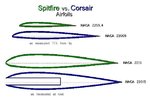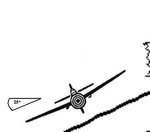A
Anonymous
Guest
The wing is angled up 4 degrees, and to counter natural lift (which the Spitfire does also) the nose must be angled downward even more to maintain level flight. On the -5 the engine was canted an additonal 2 degrees to provide ven more of a nose down flight attitude.
I think you can actually see this in side view photos, though the blue of the paint job does tend to obscure things a bit.
=S=
Lunatic
I think you can actually see this in side view photos, though the blue of the paint job does tend to obscure things a bit.
=S=
Lunatic









